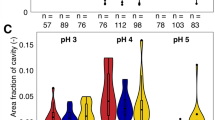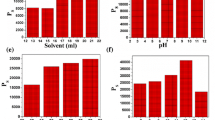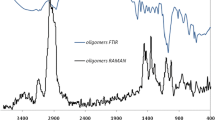Abstract
In the present study, the preparation of a novel graft yield of acrylonitrile onto cross-linked (alginate/polyvinyl alcohol) (CAP) beads was considered in the presence of potassium persulfate (KPS) as an initiator. The effects of operational parameters such as time, temperature, amount of backbone, concentration of monomer and initiator on grafting percentage were evaluated. The grafting process was modeled using the Levenberg–Marquardt algorithm of artificial neural network. The high correlation (R2 = 0.9913) between the experimental data and model outputs showed that the Levenberg–Marquardt network is able to predict the grafting of acrylonitrile on CAP backbone accurately. The physicochemical properties of grafted samples were investigated by Fourier transform infrared, scanning electron microscopy and thermogravimetric analysis (TGA). The decomposition temperature values obtained from TGA demonstrated that the thermal stability of CAP increased as a result of grafting. Finally, the results showed that grafting of acrylonitrile onto CAP beads successfully occurred under studied experimental conditions.
Graphic abstract









Similar content being viewed by others
References
Jung CH, Lee JS, Kim DK, Hwang IT, Nho YH, Choi JH (2008) Preparation of poly (acrylic acid)-grafted polystyrene beads by radiation-induced graft polymerization. Appl Chem 12:265–268
Lopes D, Ferreira MJ, Russo R, Dias JM (2015) Natural and synthetic rubber/waste–ethylene-vinyl acetate composites for sustainable application in the footwear industry. J Clean Prod 92:230–236
Lee KY, Mooney DJ (2012) Alginate: properties and biomedical applications. Prog Polym Sci 37:106–126
Singh L, Pavankumar AR, Lakshmanan R, Rajarao GK (2012) Effective removal of Cu2+ ions from aqueous medium using alginate as biosorbent. Ecol Eng 38:119–124
Fourest E, Volesky B (1997) Alginate properties and heavy metal biosorption by marine algae. Appl Biochem Biotechnol 67:215–226
Bée A, Talbot D, Abramson S, Dupuis V (2011) Magnetic alginate beads for Pb(II) ions removal from wastewater. J Colloid Interface Sci 362:486–492
Oladipo AA, Gazi M (2015) Nickel removal from aqueous solutions by alginate-based composite beads: central composite design and artificial neural network modeling. J Water Process Eng 8:e81–e91
Wang LF, Rhim JW (2015) Preparation and application of agar/alginate/collagen ternary blend functional food packaging films. Int J Biol Macromol 80:460–468
Sun J, Tan H (2013) Alginate-based biomaterials for regenerative medicine applications. Materials 6:1285–1309
D’Ayala G, Malinconico M, Laurienzo P (2008) Marine derived polysaccharides for biomedical applications: chemical modification approaches. Molecules 13:2069–2106
Siripattanakul S, Pochant CJ, Khan E (2010) Nitrate removal from agricultural infiltrate by bioaugmented free and alginate entrapped cells. Water Environ Res 82:617–621
Shaari N, Kamarudin SK (2015) Chitosan and alginate types of bio-membrane in fuel cell application: an overview. J Power Sources 289:71–80
Adoor SG, Manjeshwar LS, Aminabhavi TM (2008) Blend membranes of sodium alginate/poly (styrene sulfonic acid) for isopropanol dehydration. Des Monomers Polym 11:147–157
Lee JS, Heo SA, Jo HJ, Min BR (2016) Preparation and characteristics of cross-linked cellulose acetate ultrafiltration membranes with high chemical resistance and mechanical strength. React Funct Polym 99:114–121
Jamal NA, Anuar H, Bahri AR (2011) Enhancing the mechanical properties of cross-linked rubber-toughened nanocomposites via electron beam irradiation. J Nanotechnol 2011:1–8
Ikada Y (1992) Comparison of surface modification of polymers by different methods. Int J Radiat Appl Instrum Part C Radiat Phys Chem 39:509–511
Ren PF, Fang Y, Wan LS, Ye XY, Xu ZK (2015) Surface modification of polypropylene microfiltration membrane by grafting poly (sulfobetaine methacrylate) and poly (ethylene glycol): oxidative stability and antifouling capability. J Membr Sci 492:249–256
Liu Y, Li Y, Yang L, Liu YU, Bai L (2005) Graft copolymerization of methyl acrylate onto sodium alginate initiated by potassium diperiodatocuprate (III). Iran Polym J 14:457–463
Sorour M, El-Sayed M, El Moneem NA, Talaat H, Shaalan H, El Marsafy S (2013) Free radical grafting kinetics of acrylamide onto a blend of starch/chitosan/alginate. Carbohydr Polym 98:460–464
Radhakrishnan N, Lakshminarayana Y, Devi SU, Srinivasan KSV (1994) Studies on the graft copolymerization of acrylonitrile onto sodium alginate. J Macromol Sci Pure Appl Chem 31:581–591
Taghizadeh MT, Mafakhery S (2001) Kinetics and mechanism of graft polymerization of acrylonitrile onto starch initiated with potassium persulfate. J Sci Islam Repub Iran 12:333–338
Maia AM, Silva HV, Curti PS, Balaban RC (2012) Study of the reaction of grafting acrylamide onto xanthan gum. Carbohydr Polym 90:778–783
Mondal MIH, Alam R, Sayeed MA (2004) Graft copolymerization of nitrile monomers onto bleached jute fiber using potassium persulfate system and their textile characteristics. J Appl Polym Sci 92:3622–3629
Wang L, Xu Y (2006) Graft copolymerization kinetics of ethyl acrylate onto hydroxypropyl methylcellulose using potassium persulphate as initiator in aqueous medium. Iran Polym J 15:467–475
Singha AS, Rana AK (2012) Preparation and characterization of graft copolymerized Cannabis indica L. fiber-reinforced unsaturated polyester matrix-based biocomposites. J Reinf Plast Compos 31:1538–1553
Lee YH, Kim JS, Kim HD (2005) A study of biodegradable superabsorbent materials based on acrylonitrile grafted sodium alginate. Key Eng Mater 277:450–454
Salisu A, Sanagi MM, Naim AA, Karim KJA, Ibrahim WAW, Abdulganiyu U (2016) Alginate graft polyacrylonitrile beads for the removal of lead from aqueous solutions. Polym Bull 73:519–537
Salisu A, Sanagi MM, Naim AA, Karim KJ (2015) Removal of methylene blue dye from aqueous solution using alginate grafted polyacrylonitrile beads. Der Pharma Chem 7:237–242
Chhatbar MU, Meena R, Prasad K, Siddhanta AK (2009) Agar/sodium alginate-graft-polyacrylonitrile, a stable hydrogel system. Indian J Chem 48A:1085–1090
Kamoun EA, Chen X, Eldin MSM, Kenawy ERS (2015) Crosslinked poly (vinyl alcohol) hydrogels for wound dressing applications: a review of remarkably blended polymers. Arab J Chem 8:1–14
Caykara T, Demirci S (2006) Preparation and characterization of blend films of poly (vinyl alcohol) and sodium alginate. J Macromol Sci Part A 43:1113–1121
El-Din HMN, Alla SGA, El-Naggar AWM (2007) Swelling, thermal and mechanical properties of poly (vinyl alcohol)/sodium alginate hydrogels synthesized by electron beam irradiation. J Macromol Sci Part A Pure Appl Chem 44:291–297
Trivedi J, Bhatt T, Trivedi H (2014) Synthesis and characterization of poly (butyl methacrylate) grafted sodium salt of partially carboxymethylated guar gum. Cellul Chem Technol 48:503–514
Podder MS, Majumder CB (2016) The use of artificial neural network for modelling of phycoremediation of toxic elements As (III) and As (V) from wastewater using Botryococcus braunii. Spectrochim Acta Part A Mol Biomol Spectrosc 155:130–145
Rasoulifard MH, Dorraji MS, Amani-Ghadim AR, Keshavarz-Babaeinezhad N (2016) Visible-light photocatalytic activity of chitosan/polyaniline/CdS nanocomposite: kinetic studies and artificial neural network modeling. Appl Catal A 514:60–70
Shojaeimehr T, Rahimpour F, Khadivi MA, Sadeghi M (2014) A modeling study by response surface methodology (RSM) and artificial neural network (ANN) on Cu2+ adsorption optimization using light expended clay aggregate (LECA). J Ind Eng Chem 20:870–880
Hassani A, Vafaei F, Karaca S, Khataee AR (2014) Adsorption of a cationic dye from aqueous solution using Turkish lignite: kinetic, isotherm, thermodynamic studies and neural network modeling. J Ind Eng Chem 20:2615–2624
Dalkilic AS, Çebi A, Celen A, Yıldız O, Acikgoz O, Jumpholkul C, Wongwises S (2016) Prediction of graphite nanofluids’ dynamic viscosity by means of artificial neural networks. Int Commun Heat Mass Transf 73:33–42
Benedetti M, Cesarotti V, Introna V, Serranti J (2016) Energy consumption control automation using artificial neural networks and adaptive algorithms: proposal of a new methodology and case study. Appl Energy 165:60–71
López ME, Rene ER, Boger Z, Veiga MC, Kennes C (2017) Modelling the removal of volatile pollutants under transient conditions in a two-stage bioreactor using artificial neural networks. J Hazard Mater 324:100–109
Daemi H, Barikani M (2012) Synthesis and characterization of calcium alginate nanoparticles, sodium homopolymannuronate salt and its calcium nanoparticles. Sci Iran 19:2023–2028
Zain NAM, Suhaimi MS, Idris A (2011) Development and modification of PVA–alginate as a suitable immobilization matrix. Process Biochem 46:2122–2129
Itou T, Kitai H, Shimazu A, Miyazaki T, Tashiro K (2014) Clarification of cross-linkage structure in boric acid doped poly (vinyl alcohol) and its model compound as studied by an organized combination of X-ray single-crystal structure analysis, Raman spectroscopy, and density functional theoretical calculation. J Phys Chem B 118:6032–6037
Author information
Authors and Affiliations
Corresponding author
Additional information
Publisher's Note
Springer Nature remains neutral with regard to jurisdictional claims in published maps and institutional affiliations.
Rights and permissions
About this article
Cite this article
Kianfar, S., Keshtkar, A.R. & Zarenezhad, B. Graft polymerization of acrylonitrile onto cross-linked (alginate/polyvinyl alcohol) beads initiated by potassium persulfate: synthesis and artificial neural network modeling. Polym. Bull. 78, 295–311 (2021). https://doi.org/10.1007/s00289-020-03106-6
Received:
Revised:
Accepted:
Published:
Issue Date:
DOI: https://doi.org/10.1007/s00289-020-03106-6




